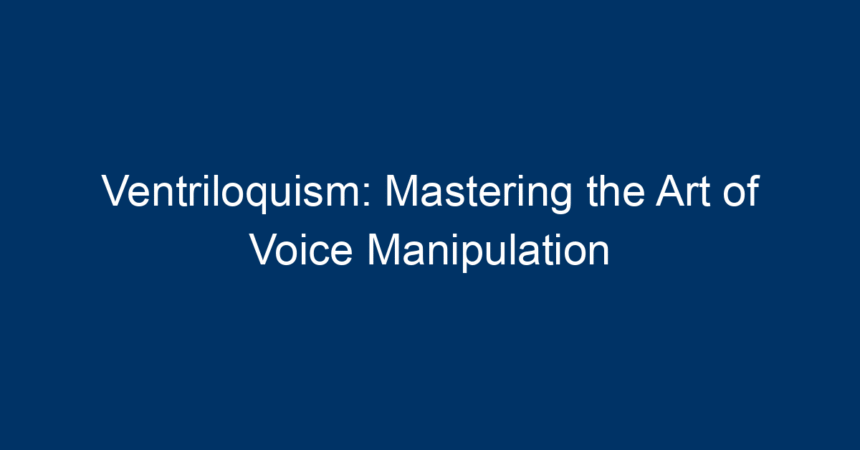Ventriloquism is an enchanting art form that captivates audiences worldwide, blending humor, storytelling, and unparalleled skill. Have you ever marveled at how a ventriloquist can speak without moving their lips while maintaining a dialogue with a puppet or dummy? This unique talent not only requires voice manipulation but also deep understanding and practice. In this article, we’ll delve into the fascinating world of ventriloquism, its history, techniques, and practical steps for mastering this extraordinary skill.
The History of Ventriloquism
Ancient Roots
Ventriloquism dates back to ancient civilizations. It was first documented in ancient Greece as a means for spiritual communication. The Greeks believed that ventriloquists could channel the voices of the dead. They would often perform in temples and settings where communication with the gods was sought.
Modern Evolution
As time progressed, the art of ventriloquism evolved. In the 19th century, it found its place in entertainment, primarily in theaters and vaudeville shows. Pioneers like Edgar Bergen and his famous puppet Charlie McCarthy brought ventriloquism to the forefront of popular culture. Bergen often used elements of humor and sarcasm, laying the groundwork for future performers.
Today, ventriloquism is not limited to stage performances. You can find talented ventriloquists in television, movies, and even social media platforms, each adapting the craft to fit contemporary audiences.
The Essentials of Ventriloquism
Understanding Voice Manipulation
At the core of ventriloquism is voice manipulation. This skill allows performers to create distinct voices for their puppets while maintaining their own natural voices. The art involves several components:
-
Articulation: Clear pronunciation of words is crucial. Practicing consonants and vowels separately can help develop clarity.
-
Pitch Variation: Differentiating between characters requires the ventriloquist to master pitch changes. Higher pitches often denote more childlike or female characters, whereas lower pitches can represent more authoritative or male characters.
- Speed and Rhythm: Adjusting speaking pace can aid in creating unique character voices. Rapid, jittery speech can evoke a sense of excitement, while slower, deliberate speech can add gravity to a character’s persona.
The Role of Body Language
A great ventriloquist relies heavily on non-verbal communication. The puppet often becomes an extension of the performer, conveying emotions and reactions through body language. Observing how different performers animate their puppets can provide invaluable insights into integrating body language effectively.
Choosing Your Puppet
The selection of a puppet can significantly impact your performance. Ventriloquists often choose characters that complement their style. Here are a few key considerations:
-
Personality: Does the puppet’s character resonate with you? A funny, quirky puppet suits a comedic style, while a serious or intriguing puppet might lend itself to dramatic storytelling.
-
Design: The appearance of the puppet can influence audience perception. A well-crafted puppet with distinct features can enhance the overall experience.
- Functionality: Ensure that the puppet is easy to manipulate. A puppet that’s cumbersome can hinder your performance and voice manipulation efforts.
Techniques to Master Ventriloquism
The Lip Control Exercise
One of the most fundamental exercises for aspiring ventriloquists is learning to speak without moving your lips. The lip control exercise involves:
- Choosing a simple phrase.
- Repeating it while consciously keeping your lips still.
- Gradually increasing the complexity of the phrases as you grow more comfortable.
Practice Vocal Techniques
To enhance your voice manipulation skills, consider these tips:
-
Vowel Sounds: Practice saying "ah," "ee," "oo," etc., while keeping your lips still. This will train your mouth to adapt to ventriloquism-style pronunciation.
- Consonant Sounds: Certain consonants, like "B," "P," and "M," are challenging because they require lip movement. Substituting these sounds with others can aid in practice—use "D" instead of "B," for instance.
Mirror Practice
Practicing in front of a mirror can significantly improve your ventriloquism skills. Observing your mouth movements will help you become aware of any unnecessary lip movement while speaking. Focus on keeping your lips relaxed as you articulate your puppet’s voice.
Building a Routine
Scriptwriting
Creating a script is an essential part of ventriloquism. Here are some tips for effective scriptwriting:
-
Character Development: Flesh out your puppet’s backstory and personality. What are their quirks and catchphrases?
-
Dialogue Structure: Write engaging dialogues that reflect both your voice and your puppet’s voice. Incorporate humor, conflicts, and resolutions to maintain audience interest.
- Timing and Pauses: Incorporate pauses strategically to allow for comedic effect and maintain audience engagement. Good pacing can elevate your performance dramatically.
Rehearsal
Rehearsing is vital to the mastery of ventriloquism. Regular practice helps solidify your techniques. Here’s an effective way to structure your rehearsals:
- Warm-up: Start with vocal warm-ups and articulation exercises.
- Character Practice: Spend time solely focusing on one character’s voice.
- Full Performances: Gradually perform full scripts, even in front of small crowds or friends, for feedback.
Performing in Front of an Audience
Building Confidence
Confidence is key in any performance art, especially in ventriloquism. Here are some techniques to build your confidence:
-
Visualize Success: Imagine successful performances and the response from your audience. Visualization can help calm nerves.
-
Start Small: Begin with small gatherings before moving to larger shows. This gradual exposure helps you acclimate to performing in front of an audience.
- Engage with the Audience: Direct engagement can enhance your performance. Make eye contact, ask questions, and integrate audience responses into your script.
Handling Mistakes Gracefully
Mistakes are inevitable, even for seasoned professionals. Here’s how to manage them smoothly:
-
Stay Calm: If a line is forgotten or a puppet malfunctions, remain composed. The audience will often appreciate your poise.
-
Use Humor: Redirect awkward moments into humor. Quick-witted responses can often turn lapses into memorable interactions.
- Practice Resilience: Each performance is a learning opportunity. Analyze what went wrong and improve for next time.
Conclusion: Your Journey in Ventriloquism
Mastering ventriloquism is not just about voice manipulation; it’s a journey of creativity, patience, and practice. By understanding its rich history, honing essential skills, and developing unique characters, aspiring ventriloquists can create captivating performances that entertain and engage audiences.
For those embarking on this journey, remember that practice truly makes perfect. Take actionable steps by creating a dedicated practice schedule, experimenting with different puppets, and honing your voice manipulation techniques. Whether you dream of performing at local shows or aspire for larger stages, ventriloquism offers a delightful outlet for creativity and joy.
Are you ready to step into the spotlight as a ventriloquist? Start today, and you might just find your voice—literally!




